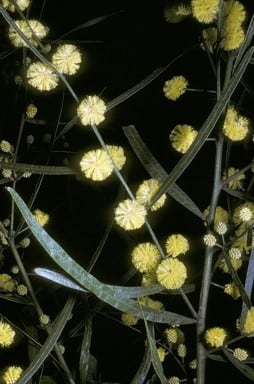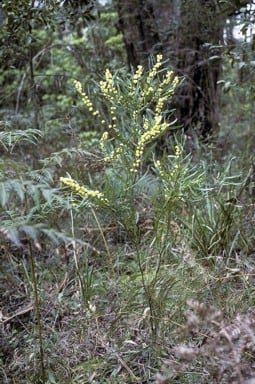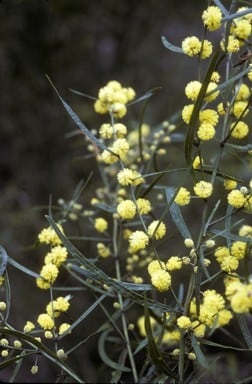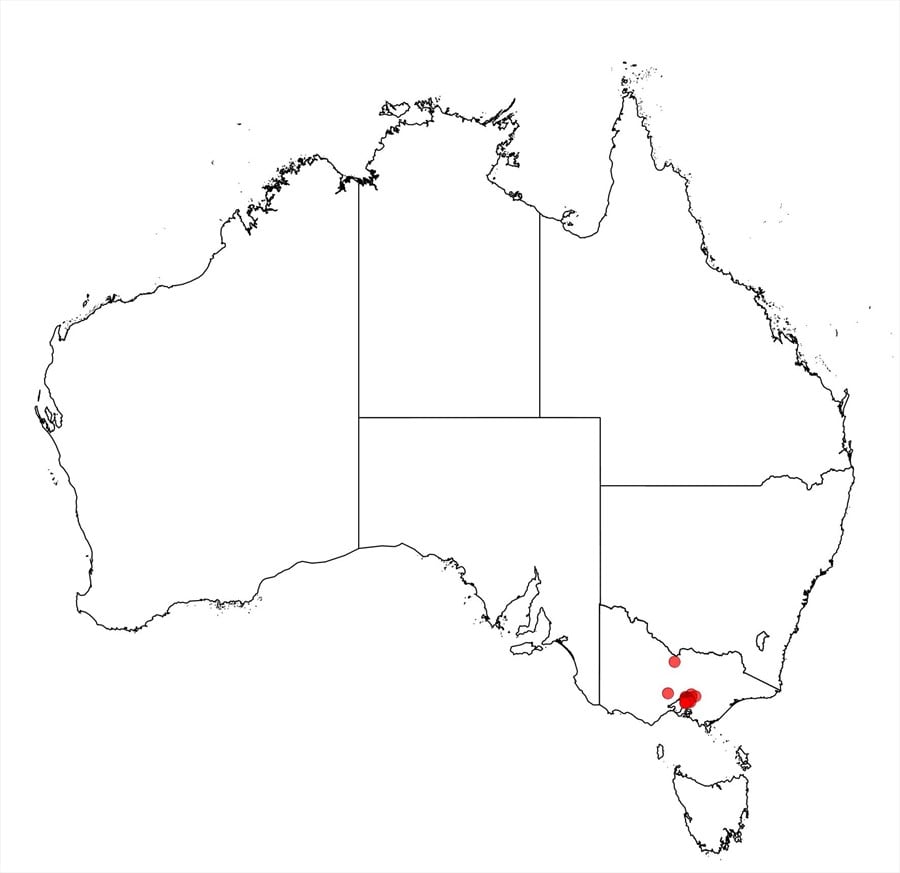Acacia stictophylla Court ex Maslin & D.J.Murphy
WATTLE
Acacias of Australia
Common Name
Dandenong Cinnamon Wattle
Family
Fabaceae
Distribution
Endemic in Vic. where it is restricted to the vicinity of the Dandenong Ranges E of Melbourne and is common in the places where it occurs.
Description
Aromatic, rounded or ±narrowly obconic shrub 2–4 m tall. Branchlets finely ribbed, the ribs glabrous or very sparsely appressed-puberulous. Phyllodes narrowly elliptic to lanceolate-elliptic, rarely ±linear, mostly (40–) 50–90 (–115) mm long, (2–) 3–6 (8–12) mm wide, shallowly to moderately incurved, sometimes straight, thin-textured, glabrous or sparsely appressed-puberulous on mid-rib and margin, resinous-puncticulate; finely 1-nerved; gland 0 (–0.5) mm above the pulvinus. Inflorescences mostly simple; peduncles 4–8 (–10) mm long, c. 0.5 mm diam., moderately densely and rather loosely pubescent with hairs tolerably long (to c. 0.5 mm); basal peduncular bract normally caducous; heads globular but buds often obloid, 30–50-flowered, lemon yellow; bracteoles exserted beyond flowers in young buds but not exserted in mature buds, acuminate to short-acuminate. Flowers 5-merous; sepals united to near. Pods linear, 20–60 mm long, 3–4 mm wide, raised over seeds along mid-line, chartaceous, glabrous to very sparsely appressed-puberulous. Seeds longitudinal, oblong, 3.5–4.5 mm long, black; arillate.
Phenology
Flowers Aug.–mid Nov; fruits Dec.
Habitat
Grows on hillsides in tall Eucalyptus forest or open woodland, on moderately steep slopes or sometimes in wet riparian vegetation along watercourses, on white sandy loam or clay derived from Silurian sandstone or mudstone.
Specimens
Vic.: Melbourne suburban area, Pamela Drive, Ringwood, D.E.Albrecht 635 (BRI, CBG, MEL, PERTH); Lower Ferntree Gully, Jul. 1942, C. Davis 9 (NSW).
Notes
Putative hybrids between A. howittii and A. stictophylla occur at Ringwood (a suburb of Melbourne), viz. D.E. Albrecht 651 & 652 and B.R. Maslin 582 (all at MEL and PERTH); see B.R.Maslin & D.Murphy (loc. cit.) for discussion. Putative hybrids between A. paradoxa and A. stictophylla occur in the same general area, e.g. B.R.Maslin 5865 (K, MEL, PERTH); these entities were reported by A.B.Court, Handb. Pl. Victoria 2: 216 (1972), where the parents were given as A. armata and A. leprosa respectively. The cultivar, Acacia leprosa ‘Weeping Cinnamon Wattle’, described and photographed by E.Brueggemeier, Australian Plants 25: 264–265 (2010) is probably referable to A. stictophylla.
Referred to as the second variant of A. leprosa by B.R.Maslin, Fl. Australia 11A: 599 (2001). Related to the more widespread and variable A. leprosa and may particularly resemble the typical variety which has less conspicuous, acute bracteoles that are not exserted in the flower buds, generally shorter peduncles and have a dense indumentum of uniformly very short, straight, closely appressed hairs, and fewer-flowered heads; see B.R.Maslin & D.Murphy, Muelleria 27: 214–215 (2009) for further discussion. Occasional specimens of A. stictophylla from near Belgrave with wider than normal phyllodes (to 12 mm) may superficially resemble A. leprosa var. uninervia (the distribution of the two taxa overlap around Woori Yallock) which is most easily distinguished by gland located 2 mm or more above pulvinus. Plants of A. stictophylla with very narrow phyllodes superficially resemble the more easterly distributed A. cognata which is distinguished by its normally 3-nerved, very obscurely puncticulate phyllodes, persistent basal peduncular bracts and taller stature. It also sometimes superficially resembles the second variant of A. verniciflua from near Seymour which is characterized by having 1-nerved phyllodes; this variant is distinguished from A. stictophylla by its normally shorter phyllodes (commonly 20–55 mm long), glabrous peduncles and by its bracteoles that are not exserted in the young buds.
FOA Reference
Flora of Australia Project
Author
B.R.Maslin
This identification key and fact sheets are available as a mobile application:
URL: https://apps.lucidcentral.org/wattle/
© Copyright 2018. All rights reserved.











